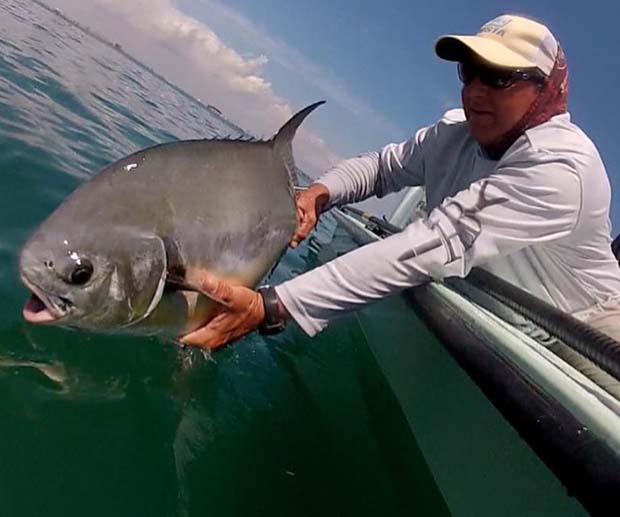April, 2015 Conservation Captain
[dropcap]T[/dropcap]he Conservation Captain for April 2015 is Abaco, Bahamas guide Capt. Buddy Pinder. Buddy, along with his wife Cindy, has been instrumental in helping BTT tag bonefish on Abaco. They have also graciously hosted BTT scientists and volunteers at their home, donated their time and boat, and they have been active in getting other guides involved with BTT. Their efforts have helped gain local community support for BTT’s bonefish conservation efforts in the Bahamas.
Click here for more info on about Capt. Buddy Pinder . . .
BTT: Where do you guide and how long have you been guiding for?
BP: My first guided fishing trip was in the now world-famous Marls of Abaco in 1990. I guided part-time from April to July until 1998 when I became a full-time bonefish guide.
BTT: How did you become a fishing guide?
BP: I made my living as a full-time lobster fisherman for more than 20 years. My father was a taxi driver and he got me my first fishing clients one summer when his customers asked about somebody to take them bonefishing. I didn’t know anything about bonefishing then, but I had grown up in The Marls, fishing and hunting (blue wing teal ducks) with my father from the time I was a little boy so I knew where the fish were. My third client brought me a fly rod and it wasn’t long before my passion for fly-fishing took root and I learned about bonefish behavior and where to fish and started building my guiding business. In 1998 I became a part-time lobster fisherman dedicating 10 months of the year to bonefishing full-time.
BTT: How many days per year do you guide?
BP: I probably guide 180 –200 days per year and I have to say, I have some the best clients anywhere!
BTT: What species do most of your clients want to fish for? Why?
BP: The Marls of Abaco is the home of some of the best bonefishing on the planet so that is what my clients want to catch when they fish with me.
BTT: Tell us about how your fishery used to be, compared to today.
BP: The fish population in The Marls was astounding after 30 years of hurricane-free seasons. Hurricane Floyd in 1999, which was horrible, killed a huge number of bonefish – maybe as much as half of the fish population. And then we had Hurricane Frances & Hurricane Jean in 2004 which were both severe and killed fish. And several more hurricanes since that were less memorable but still damaging. The most recent were Hurricane Irene in 2011 and then Hurricane Sandy in October 2012, which killed even more fish. In my estimation, the storms over the past 15 years have killed about 50% of the fish in The Marls so it has been a noticeable change since I started guiding in the early 90’s. There are also more guides and anglers fishing the area today so the fish behavior has changed.
BTT: In your opinion, what is the most important conservation issue facing your fishery right now and what can be done to help fix it?
BP: The entire area needs to be protected – The Marls, the spawning areas and the travel corridor the fish use between those areas. I, along with the Abaco Fly Fishing Guides Association, The Bahamas National Trust, Friends of the Environment on Abaco and the Bonefish & Tarpon Trust have worked very hard trying to get the areas declared national parks. Everything has been submitted to the Bahamas Government to make that happen more than a year ago but we are still waiting for them to finalize the proposal. We also have to be careful about over fishing. Too many boats in the area or fishing the same areas over and over again targeting the same fish leads to a change in the fish behavior so education of guides and anglers plays a big role too.
BTT: Despite some of the negative things happening to the fishery, why do you love it so much?
BP: Despite the changes there are still an incredible amount of bonefish in The Marls. It is truly an amazing fishery! 200 square miles of skinny water averaging a little more than a foot deep with wind-driven tides lead to entire days of perfect bonefishing. I love poling the boat, “hunting” for fish for my clients to catch. It’s a special day on the water for them and me. My days are peaceful and quiet and consist of beauty on the water, with a dash of heart-thumping excitement and fun catching bonefish, as well as great conversations with some of the nicest folks you’d ever want to meet. It really makes going to work a pleasure!
BTT: Why do you support Bonefish and Tarpon Trust?
BP: I support the BTT for the science and their teaching. My wife invited Dr. Aaron Adams to Abaco many years ago to put on a presentation for the Abaco Fly Fishing Guides Association after he published one of his first bonefishing articles in a magazine. As guides, we all wanted to know more about bonefish. We all knew things that the bonefish did but we certainly didn’t know why. Different guides on different parts of the island all saw different behaviors. When we all started talking about our little piece of the puzzle, Dr. Adams was able to put it all together for us! He was the one that realized we had found a travel corridor of spawning bonefish and the pre-spawning aggregation site. We were well aware of this behavior for more than 15 years – and in one conversation it all came together. It was an exciting meeting! We started tagging bonefish with the BTT in 2009 and have learned so much from each recapture about where our fish live and the small area that is their home range. I always suspected we were fishing the same fish but now we know for sure. That is why we have to be careful about fishing the same areas over and over again. Our behavior will affect the fishes behavior. We also learned through research with the BTT that our bonefish live long lives and are old – the average age of the fish is about 12 – 14 years old in The Marls. It’s exciting now to see many smaller fish in The Marls which leads us to believe that our fish population may be growing again.
BTT: In your opinion, what is the most important work that BTT does and why?
BP: The most important thing the BTT does is give local guides a voice and a national platform by working hand in hand with them, providing funding and science to learn about a species or fishery, provide documentation and ultimately protect the fish or the area. The guides knowledge is validated with scientific data as we learn more and become better stewards of our environment and then we can teach others about the fishery we love.
BTT: Why should a fisherman that doesn’t live in Florida or the Caribbean care about BTT?
BP: Anybody that has an interest in conservation or saltwater fishing should support the BTT. While many of my clients are from Florida I have clients from all over the world and I would hope that an angler from Alaska, Montana, Maine, England, Norway, France, Japan, Egypt, South America or South Africa to name a few, would become a member of the BTT so that they and their children and my children and I can enjoy a healthy fishery now and for generations to come. We need to preserve what we love regardless of where we live.
BTT: You have the day off. What species are you going to fish for, where are you going to find them, and what are you going to use to catch them?
BP: Lately, I’ve been doing deep-drop fishing for red snapper. I find them just off shore, in front of my house, in 400- to 600-feet of water. I go on calm days in my flats boat with a hand-held GPS and an electric rod/reel combination, some heavy leads and box of squid. They sure are good eating! If it’s not calm enough to head out into the ocean, I’ll take my wife, Cindy, bonefishing in The Marls. Sometimes I even get a chance to catch a fish or two. We use 8-weight fly rods and you will never go wrong with a pearl Gotcha tied on your leader.
BT: Tell us one of your favorite fishing stories.
BP: In the winter we get a lot of barracuda on the flats and they are good eating because there is no reef for 100 miles. Two weeks ago I was poling along and I saw a nice cuda laying up in 10-inches of water, so I grabbed a spinning rod and threw a tube lure with two treble hooks at the cuda. I rapidly reeled it past the fish and it struck the lure. I handed the rod to the lady angler I was fishing with and she started reeling it in. The cuda was only about 12-pounds but she was having one heck of a time reeling it in. She kept working at it and after about ten minutes she finally got it next to the boat. Imagine our surprise when we realized there was also a three foot, 10-pound lemon shark hooked up too! It’s not everyday that you catch a barracuda and a shark at the same time and that sure explained why it was so hard reeling it in. That’s a fishing day she’ll never forget and that’s the first time a shark/cuda hook up has ever happened to me in 25 years too!
[information]
Get bonefish, tarpon and permit updates, destination information and angling tips & tactics – Join BTT . . .
[/information]




